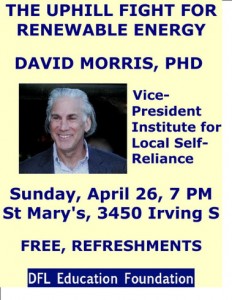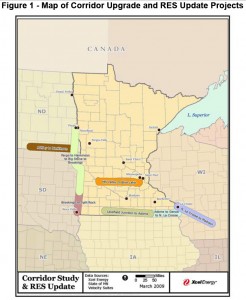David Morris on PUC process and Capx 2020 decision
April 24th, 2009
Once more, it’s David Morris, Institute for Local Self Reliance, telling it like it is. The PUC process is long over do a complete revamping. It is based on laws and rules that grew out of the 1970s-1980s transmission fights, and gave people a useful and meaningful way to participate in these proceedings. But that’s gone, gone with the 2001 changes, gone with the 2005 Transmission Omnibus Bill from Hell, and we’re left with just about nothing. In other states, there’s Intervenor Compensation which allows Intervenors the ability to pay for expert witnesses, there are free transcripts as a matter of course, and there’s encouragement and support of Intervenors, not a drive to push them out of the process that we see here, that we saw in this CapX proceeding, when the ALJ tried to boot out U-CAN; that we saw in the Excelsior Energy docket (scroll down to “Fourth Prehearing Order”).
David Morris: If it’s citizens vs. utilities, utilities win
The PUC has an approval process that stacks the deck against the public.
By DAVID MORRIS
Last update: April 23, 2009 – 6:50 PM
A few days ago, the Minnesota Public Utilities Commission (PUC) approved a massive high-voltage transmission project known as CapX that will cost Minnesotans an amount equal to the projected biennial state budget deficit and four times the total bill to taxpayers for the Twins and Gophers stadiums.
With respect to the stadiums, Minnesotans were able to actively participate in the decisions, both directly and indirectly through elected representatives. Both those in favor and those opposed to using tax dollars to pay for the stadiums engaged in a spirited public debate. The Legislature is currently just as vigorously debating ways it can eliminate the budget deficit.
The PUC process, on the other hand, is much more hostile to citizen participation and influence. Indeed, the deck is stacked against the average citizen. Utilities have a virtually unlimited budget to argue their positions — a budget they raise from their ratepayers. Citizens, on the other hand, must raise their own money, and lots of it, to participate effectively.
The rules under which the PUC operates are established by the Legislature. Utility lobbyists are powerful there. But they’re not all-powerful. Thus, over the years, Minnesotans have been able to enact rules to help level the playing field for citizens. For example, the law requires the PUC to reject an application to build a large power plant or a high-voltage transmission line unless the utility proves it is needed to improve reliability or meet increased demand or achieve renewable-energy goals. As part of the application, the utility is expected to thoroughly and completely explore alternatives to its proposal, including no-build options. The burden of proof on whether a project is needed rests with the utilities.
The PUC, regrettably, has interpreted this rule so as to turn it on its head. At the PUC, the burden of proof rests with those opposed to a new power plant or high-voltage transmission line. It is up to the people whose homes and farms may be seized by utilities if a project is approved to make the case for alternatives. Doing so requires an extremely high level of technical expertise. A serious technical and economic examination of alternatives can cost $100,000 to $200,000 or more.
Even if citizens are able to raise that kind of money, they face other hurdles. To analyze alternatives, they must access data that only utilities possess. In many cases, the utilities call that data proprietary and argue that to make the information public is to give a possible advantage to a competitor. One would think that this would be a hard argument to make. After all, Minnesota utilities have a monopoly on the sale of electricity. Apparently, however, it is not a hard argument to make at the PUC.
A formal proceeding, such as a judicial proceeding, involves the cross-examination of witnesses. In many proceedings, utilities again tax their customers by using ratepayer money to acquire a transcript. One would think that since the transcript is in electronic form, the PUC would post it and make it freely available to the public. Astonishingly, the PUC rules state that court reporters own the transcript! Citizens and other intervenors must pay for their own copies of transcripts, which, for controversial projects, could mean $5,000 to $10,000 per copy.
In the recent CapX transmission case, the PUC went one step further in denying citizens. The need for the transmission lines was based in large part on a projection of significantly increasing demand. That projection was largely made in forecasts completed in 2004. It has already proven to be vastly overstated. Moreover, the current economic collapse is translating into shrinking, not growing, electricity demand. Hundreds of citizens asked the PUC to take this new information into account and keep the proceeding open. The PUC decided the current economic free fall doesn’t make a difference.
Utilities are gearing up to ask the PUC to spend billions more for even higher-voltage transmission lines. These will be built to send electricity from the Dakotas to Chicago and New York while running right through Minnesota. If these lines are approved, Minnesotans will probably pay most of the costs, while receiving little if any benefit.
Imagine if legislators proposed taxing us to build a sports stadium in Chicago. The proposal would be dead on arrival. Citizens have influence and even power in the Legislature. The process and rules at the PUC must be redesigned to allow them similar access and influence over energy decisions.
David Morris is vice president of the Institute for Local Self-Reliance, based in Minneapolis and Washington, D.C.
CapX 2020 Certificate of Need at PUC
April 13th, 2009
This is a big week at the Minnesota Public Utilities Commission. They’re going to hear our arguments and decide whether CapX 2020 transmission, Phase I, is “needed” or not… a lot is riding on this, the direction of Minnesota’s energy future. Will we be doing it differently, or will we be stuck in the same central station coal scenario?
CapX Certificate of Need Argument & Deliberation
April 15th & 16, starting at 9:30 a.m.
Public Utilities Commission
Large Hearing Room – 3rd Floor
121 – 7th St. East
St. Paul, MN 55101
ANOTHER TRANSMISSION PLAN FROM HELL…
April 3rd, 2009
From the folks who brought you CapX 2020, today we get even more…
Here’s a link over to my other site — I’ll post a map and more tomorrow, but for now, go over to www.nocapx2020.info
CLICK HERE: ALL ABOUT THE NEW TRANSMISSION PLAN FROM HELL
How dare they… and on the eve of the CapX 2020 Certificate of Need oral argument and deliberation, whatever are they thinking… I do not understand
GSDs – out from under CapX 2020!
April 2nd, 2009
Here are the most adorable German Shepherds, available now. Just so happens that they’re in the planned CapX 2020 transmission preferred route, in a substation siting circle! So, rather than “Buy the Farm,” get these little grrrrrrrls away from CapX! “Buy the Shep!” They’re all females and are such sweeties. They’re from a litter of 11, 2 males and 9 females, and now there’s only 6 looking for homes. They’re just west of New Prague, at Union Hill.
GERMAN SHEPHERD PUPS 8 wks, 6 F healthy, farm rsd, both parents on site $450
952-393-1121 952-564-1082
NYISO and ISO-NE withdraw from publication of JCSP
February 11th, 2009
I know, that’s a lot of alphabet soup, so let’s do that first.
NYISO is the New York Independent Service Operator, the transmission operator for New York.
ISO-NE is the Independent Service Operator of New England, the transmission operator for New England.
JCSP is the Joint Coordinated system Planning Initiative, conducted by most of the transmission planning entities in the Eastern Interconnect. Each ISO has a JCSP committee, I’m most familiar with the MISO JCSP efforts (AAAAARGH!). I’ve just spent half an hour searching MISO and can’t find the JCSP section, more AAAAAAAARGH… here’s a small piece:
Anyway, as you all know, the “Green Power Express” has been announced, roaring through the Midwest towards the east, a CapX 2020 on steroids.
JCSP has put out a plan, and NYISO and ISO-NE said: PPPPPPPPBBBBBBBFT, I don’t think so, we don’t want to join in publication of this report due to your lack of consideration of efforts we’re doing here, and that you’ve got a lot of coal expansion in your plan. Well, that’s my translation. What do you think?
Here’s their Frbruary 4, 2009 letter to JCSP:
Here it is, do read it yourself and CHEER and SNORT! They have nailed it (EMPHASIS ADDED):
February 4, 2009
TO: THE JOINT COORDINATED SYSTEM PLANNING INITIATIVE
ISO New England and the NYISO are pleased to participate in the Joint Coordinated System Plan (JCSP) initiative that comprises nearly all of the regional planning entities for the Eastern Interconnection. We believe this type of broad, long-term and cooperative approach to power system planning and development is important to inform federal energy policy under the new administration.
The JCSP is a highly valuable activity with respect to the collaboration it promotes among the regional planning organizations within the Eastern Interconnection and the tools it has developed. Even at this early stage of the process, the JCSP has established a framework in which to study the entire Eastern Interconnection in a single multi-regional analysis and developed a common database of information that can be used as a starting point for future studies.
The current JCSP reports on the activities undertaken in 2008, presents analyses of two wind expansion scenarios, that also assume significant baseload coal expansion, and recommends further scenarios for the group to study. ISO New England and NYISO support the JCSP recommendation to pursue additional studies and scenarios and believe these steps are required prior to reaching any broad conclusions on the need for, and scope of, development of large scale transmission. In this regard, the 2008 JCSP report cannot be viewed as a “plan” to be relied upon for decision-making purposes and we believe its publication is premature.
Our primary concern is that the report portrays its analyses to date as a basis for federal policy discussions and decisions regarding major transmission development, as it relates to the integration of renewable resources, notwithstanding the recognized need for additional work. Until additional scenarios that include the development of local resources are analyzed, we do not believe any single transmission plan can be presented as a solution to the integration of additional renewable energy resources in the United States. Conversely, there is significant value in the JCSP studies for policymakers if appropriately presented as technical scenario analysis — coupled with the incorporation of specific planning work already underway in the various regions, including New England and New York, to integrate local renewable resources.
We also have concerns about the inclusion of issues such as cost allocation and “value based planning” considerations in the JCSP report. Since the JCSP is not itself a policy making body, we do not believe these issues should be part of the current scope nor are they appropriate for future JCSP efforts. In fact, we feel that issuing the report as it stands has the potential to constrain future collaboration, and at worst, stimulate counter-productive debate amongst regional planning organizations at it relates to these two policy areas.
In order to ensure that ISO New England’s and NYISO’s specific concerns are fully understood, below is a description of some of the specific activities and initiatives going on in the region and an explanation of how we believe they impact certain JCSP study assumptions and future efforts.
The New England Governors have been working actively for the past two years, not only among the six states in the region, but also in collaboration with the five eastern Canadian provinces of Quebec, Ontario, Newfoundland and Labrador, New Brunswick and Nova Scotia, to consider the integrated development of renewable and non-carbon emitting resources. Numerous proposals to develop renewables within the region (over 4800 MW in the current ISO New England Interconnection queue), including two major off shore wind projects, are being pursued by private entities. The governors and energy policymakers strongly support these developments and view them as economic development opportunities for their states — as well as for advancing air quality and energy security goals. Recently, the governors asked ISO New England for assistance in creating a “blueprint” for developing regional energy resources and overcoming transmission barriers to enhance the energy independence of the region. Furthermore, a number of initiatives in the New England states are promoting energy
efficiency and smart grid technologies. These are in addition to demand resources that are expected to comprise over 8% of the resources procured for our Forward Capacity Market for the year 2011.New York State has put into place an aggressive policy to incent the development of a substantial level of both renewable resources as well as energy efficiency. In his recent State-of-the-State message Governor Paterson announced a further expansion of the State’s efforts to achieve a “45×15” goal: i.e. a 30% level of renewable resources and a 15% reduction in the forecasted energy usage in the State by the year 2015. The energy efficiency program alone, if these goals are achieved, will reduce statewide electric demand by over 5000MW. New York already has nearly 1000MW of wind resources now in operation and the NYISO has another 8000MW in its interconnection queue, including off-shore projects totaling over 1200MW. The NYISO is working with regulators and stakeholders in New York to analyze the local transmission reinforcements that may be required to fully integrate such substantial local wind resources into the wholesale electric markets for the benefit of all consumers in the State.
With the shared geography and history of energy trading patterns between New York and New England with Eastern Canada, significant consideration is also being given to transmission options that would strengthen our access to new supplies of renewable energy—both hydro and wind—now being developed north of our states in Canada. Given these activities, it is reasonable to assume that these resources being developed in the Northeast may be deliverable to customers in our region sooner and more cost-effectively than Midwest wind resources. Given the renewable development, energy efficiency, and likelihood of new ties to Canada, the need to construct long transmission lines to the Midwest would likely be reduced and in turn overall transmission costs may be lower. We believe New England and New York policymakers and stakeholders should have the opportunity to compare such a scenario with the scenarios assumed in the current JCSP report and urge that they be included in future JCSP planning efforts.
We note that the report also assumes the development of new coal-fired generation in the Midwest without recognition of current and future restrictions on carbon emissions and their associated costs. While there is significant uncertainty about the details and timing of federal regulations for carbon, the Regional Greenhouse Gas Initiative (“RGGI”) is in effect today in New England, New York and other Northeast states and its impacts on generation from coal fired resources remains to be seen. In addition, we believe it is likely that the transmission and wind project capital cost estimates contained in the initial JCSP are understated and suggest that modifications to the estimates and estimating process would help to develop a better understanding of the true costs of the expansion scenarios. Future JCSP efforts should also include the ability of stakeholders in the various regions to consider and comment on the assumptions used for these estimates.
These factors, especially the lack of recognition of important New England and New York-specific circumstances require that ISO New England and NYISO withdraw from the publication of the current JCSP study. Despite our inability to participate in the JCSP 2008 report, we intend to continue to participate and work collaboratively towards the modifications suggested above. In order to advance the positive steps made by the participants and the Department of Energy toward joint planning initiatives, we hope that agreement can be reached on the charter, governance and scope of additional JCSP planning efforts and an improved regional stakeholder review process.
Sincerely,
Gordon van Welie
President & Chief Executive Officer
ISO New England Inc.Stephen G. Whitley President & Chief Executive Officer New York Independent System Operator
WELL SAID!!!
Many thanks to the little birdie who sent this:






